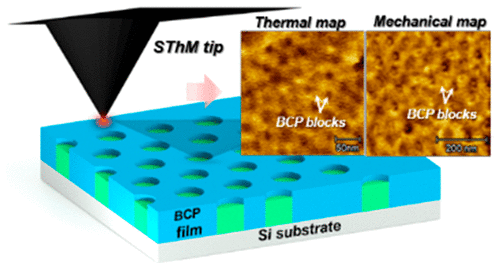当前位置:
X-MOL 学术
›
ACS Appl. Polym. Mater.
›
论文详情
Our official English website, www.x-mol.net, welcomes your
feedback! (Note: you will need to create a separate account there.)
Nanoscale Mapping of Thermal and Mechanical Properties of Bare and Metal-Covered Self-Assembled Block Copolymer Thin Films
ACS Applied Polymer Materials ( IF 4.4 ) Pub Date : 2019-12-31 , DOI: 10.1021/acsapm.9b00924 Alexandros El Sachat 1 , Jean Spièce 2 , Charalambos Evangeli 2 , Alexander James Robson 2 , Martin Kreuzer 1 , Maria R. Rodríguez-Laguna 1 , Emigdio Chavez 1 , Marianna Sledzinska 1 , Clivia M. Sotomayor Torres 1, 3 , Oleg V. Kolosov 2 , Francesc Alzina 1
ACS Applied Polymer Materials ( IF 4.4 ) Pub Date : 2019-12-31 , DOI: 10.1021/acsapm.9b00924 Alexandros El Sachat 1 , Jean Spièce 2 , Charalambos Evangeli 2 , Alexander James Robson 2 , Martin Kreuzer 1 , Maria R. Rodríguez-Laguna 1 , Emigdio Chavez 1 , Marianna Sledzinska 1 , Clivia M. Sotomayor Torres 1, 3 , Oleg V. Kolosov 2 , Francesc Alzina 1
Affiliation

|
We report on the structural, mechanical, and thermal analysis of 40 nm thick polystyrene-block-poly(ethylene oxide) (PS-b-PEO) block copolymer (BCP) films coated with evaporated chromium layers of different thicknesses (1, 2, and 5 nm). Solvent annealing processes allow the structural control of the BCP films morphology by rearranging the position of the PEO cylinders parallel to the substrate plane. High-vacuum scanning thermal microscopy and ultrasonic force microscopy measurements performed in ambient pressure revealed that coated ultrathin metal layers strongly influence the heat dissipation in the BCP films and the local surface stiffness of the individual BCP domains, respectively. The measured tip–sample effective thermal resistance decreases from 6.1 × 107 to 2.5 × 107 K W–1 with increasing Cr film thickness. In addition, scanning probe microscopy measurements allow the thermal and mechanical mapping of the two segregated polymer domains (PEO–PS) of sub-50 nm characteristic sizes, with sub-10 nm thermal spatial resolution. The results revealed the effect of the surface morphology of the BCP and the incorporation of the metal film on the nanoscale thermal properties and volume self-assembly on the mechanical properties. The findings from this study provide insight into the formation of high aspect ratio BCP–metal structures with the more established applications in lithography. In addition, knowledge of the thermal and mechanical properties at the nanoscale is required in emergent applications, where BCPs, or polymers in general, are part of the structure or device. The performance of such devices is commonly related to the requirement of increased heat dissipation while maintaining mechanical flexibility.
中文翻译:

裸露和金属覆盖的自组装嵌段共聚物薄膜的热力学性能的纳米级制图
我们报告了40纳米厚的聚苯乙烯-嵌段-聚(环氧乙烷)(PS- b - PEO)嵌段共聚物(BCP)膜的结构,机械和热分析,该膜涂有不同厚度的蒸发铬层(1、2,和5 nm)。溶剂退火工艺通过重新排列平行于基材平面的PEO圆柱的位置,可以控制BCP膜的形貌。在环境压力下进行的高真空扫描热显微镜和超声力显微镜测量显示,涂覆的超薄金属层分别强烈影响BCP膜中的散热和各个BCP域的局部表面刚度。测得的针尖样品有效热阻从6.1×10 7降低到2.5×10 7 KW –1随着Cr膜厚度的增加。此外,扫描探针显微镜测量可以对两个分离的聚合物区域(PEO-PS)进行热和机械作图,这些区域的特征尺寸小于50 nm,热空间分辨率小于10 nm。结果揭示了BCP的表面形态以及金属膜的掺入对纳米级热性能和体积自组装对机械性能的影响。这项研究的发现提供了对高纵横比BCP-金属结构形成的深入了解,并在光刻技术中有了更广泛的应用。另外,在紧急应用中需要了解纳米级的热和机械性能,在紧急应用中,BCP或一般的聚合物是结构或设备的一部分。
更新日期:2019-12-31
中文翻译:

裸露和金属覆盖的自组装嵌段共聚物薄膜的热力学性能的纳米级制图
我们报告了40纳米厚的聚苯乙烯-嵌段-聚(环氧乙烷)(PS- b - PEO)嵌段共聚物(BCP)膜的结构,机械和热分析,该膜涂有不同厚度的蒸发铬层(1、2,和5 nm)。溶剂退火工艺通过重新排列平行于基材平面的PEO圆柱的位置,可以控制BCP膜的形貌。在环境压力下进行的高真空扫描热显微镜和超声力显微镜测量显示,涂覆的超薄金属层分别强烈影响BCP膜中的散热和各个BCP域的局部表面刚度。测得的针尖样品有效热阻从6.1×10 7降低到2.5×10 7 KW –1随着Cr膜厚度的增加。此外,扫描探针显微镜测量可以对两个分离的聚合物区域(PEO-PS)进行热和机械作图,这些区域的特征尺寸小于50 nm,热空间分辨率小于10 nm。结果揭示了BCP的表面形态以及金属膜的掺入对纳米级热性能和体积自组装对机械性能的影响。这项研究的发现提供了对高纵横比BCP-金属结构形成的深入了解,并在光刻技术中有了更广泛的应用。另外,在紧急应用中需要了解纳米级的热和机械性能,在紧急应用中,BCP或一般的聚合物是结构或设备的一部分。











































 京公网安备 11010802027423号
京公网安备 11010802027423号